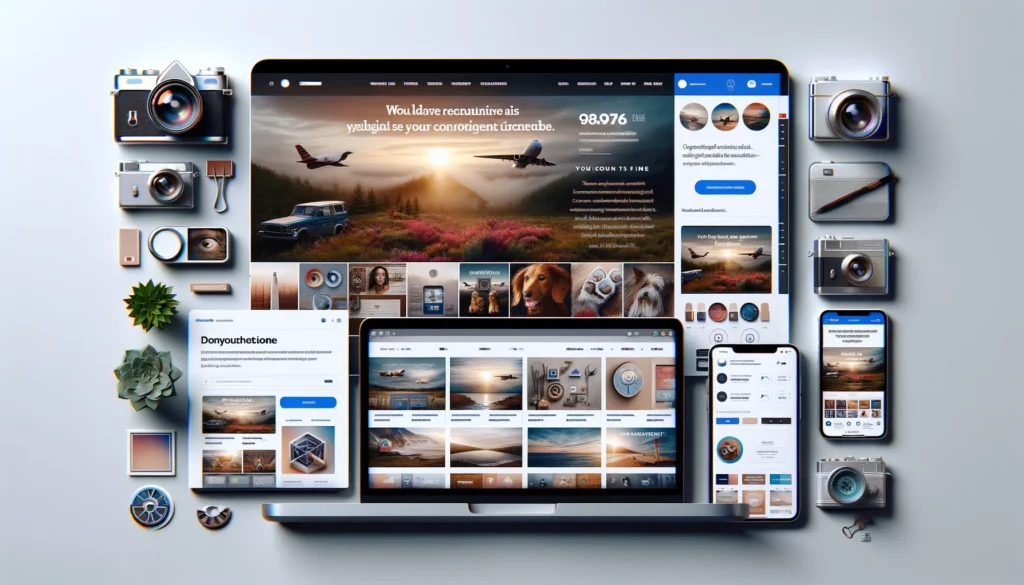Unlock the secrets to a successful omnichannel strategy and transform your customer experience. Learn actionable steps for small businesses to integrate seamless, cross-channel engagements that delight at every touchpoint.
Key Takeaways
- Understand what an omnichannel strategy is and its importance for small businesses.
- Discover the difference between omnichannel and multichannel approaches.
- Learn how omnichannel strategies enhance customer experiences and business growth.
Table of Contents
Introduction
Imagine walking into your favorite coffee shop, where the barista greets you by name, remembers your usual order, and asks if you’d like the usual or something new from the menu you were browsing on their app earlier. This personalized, seamless experience doesn’t just happen by chance; it’s the result of a well-executed omnichannel strategy.
In today’s digital age, customers interact with businesses through more channels than ever before — from social media and websites to in-person visits and phone calls. For small business owners, the challenge and opportunity lie in creating a unified, seamless customer experience across all these platforms. That’s where an omnichannel strategy comes into play, blending various channels to work together harmoniously, ensuring that no matter how or where your customers interact with your business, they receive a consistent, high-quality experience.
This post will dive into the world of omnichannel strategies, focusing on why they’re crucial for small businesses aiming to enhance customer experience and business growth. We’ll explore what makes an omnichannel approach different from multichannel strategies, the benefits of implementing it, and practical steps to get started.
Understanding Omnichannel Strategy
What Is Omnichannel?
At its core, an omnichannel strategy is about providing a consistent, integrated customer experience across all channels and touchpoints. It’s a holistic approach that considers the entire customer journey, from first awareness through to purchase and beyond, ensuring that each interaction is connected and seamless. This strategy recognizes that customers may start their journey on one channel and continue on another, expecting a fluid experience throughout.
Why Omnichannel Matters for Small Businesses
For small businesses, adopting an omnichannel approach can be a game-changer. Here’s why:
- Enhanced Customer Experience: Customers today expect convenience, speed, and personalization. An omnichannel strategy meets these expectations, improving satisfaction and loyalty.
- Increased Sales: A seamless experience can encourage customers to make purchases across multiple channels, boosting your bottom line.
- Competitive Advantage: In a crowded market, offering a cohesive and personalized customer experience can set your small business apart from competitors.
The Difference Between Multichannel and Omnichannel
While both multichannel and omnichannel involve interacting with customers through multiple channels, the key difference lies in integration and consistency. Multichannel strategies often operate in silos, with each channel functioning independently. Omnichannel, however, integrates these channels, ensuring that the customer receives a unified experience. For instance, a customer might see a product on Instagram, research it on your website, and receive personalized recommendations in-store — all seamlessly connected.
By embracing an omnichannel strategy, small businesses can offer unparalleled customer experiences that not only meet but exceed expectations, fostering loyalty and driving growth. Stay tuned as we delve deeper into designing and implementing your omnichannel experience, ensuring your small business stands out in today’s digital landscape.
Designing the Omnichannel Experience
Crafting an omnichannel experience that delights customers at every touchpoint requires thoughtful planning and design. By applying design thinking principles, small businesses can create customer journeys that are not just seamless but also deeply engaging and personalized. This section explores how to map out your customer journey, identify key touchpoints, and create a unified brand experience.
The Role of Design Thinking
Design thinking is a problem-solving approach that prioritizes the needs and experiences of the user. In the context of an omnichannel strategy, it involves understanding your customers’ behaviors, preferences, and pain points as they interact with your brand across different channels. This empathy enables small businesses to design solutions that meet customers where they are, providing value and convenience at every step.
Mapping the Customer Journey
Identifying Key Touchpoints
The first step in designing your omnichannel experience is to map out the customer journey, identifying all the potential touchpoints where customers interact with your brand. These could range from social media ads and website visits to in-store interactions and post-purchase support. The goal is to understand the path your customers take, including where they switch between channels and what triggers those changes.
Understanding Customer Needs and Expectations
Once you’ve mapped out the touchpoints, the next step is to dive deeper into understanding what your customers need and expect at each stage. This might involve conducting surveys, analyzing behavior data, or even direct conversations with customers. The insights gained will guide the creation of tailored experiences that meet or exceed customer expectations.
Creating a Unified Brand Experience
Consistency Across Channels
A cornerstone of a successful omnichannel strategy is consistency. Your brand’s messaging, tone, and visual identity should be cohesive across all channels. This consistency reassures customers and builds trust, making the overall experience feel familiar and reliable, no matter how or where they choose to engage with your brand.

Personalization and Engagement
Beyond consistency, personalization is key to creating engaging customer experiences. Using data collected from various touchpoints, small businesses can tailor communications, offers, and services to match individual customer preferences and behaviors. Personalized experiences make customers feel valued and understood, fostering loyalty and encouraging repeat business.
Incorporating these elements into your omnichannel strategy not only elevates the customer experience but also positions your small business as attentive and customer-centric. By focusing on design thinking, journey mapping, and personalization, you can create a seamless and memorable omnichannel experience that stands out in a competitive marketplace.
Implementing Your Omnichannel Strategy
After laying the groundwork with a comprehensive understanding of what your omnichannel strategy should look like and designing a customer-centric experience, it’s time to put that plan into action. Implementing your omnichannel strategy involves integrating the right technology solutions, ensuring your team is prepared to deliver consistent experiences, and establishing metrics to measure success and facilitate continuous improvement.
Integrating Technology Solutions
CRM Systems
A Customer Relationship Management (CRM) system is vital for managing customer interactions across different channels. It helps you track customer behavior, preferences, and history, enabling personalized engagement. Choose a CRM that integrates easily with your other systems (like your POS, website, and email marketing tools) to have a unified view of each customer.
Digital Marketing Tools
To effectively reach and engage customers across multiple channels, leverage digital marketing tools that allow for targeted campaigns, automated workflows, and detailed analytics. These tools can help you deliver personalized messages and offers to the right people at the right time, increasing the effectiveness of your omnichannel strategy.
Training Your Team for Omnichannel Success
For your omnichannel strategy to be effective, every member of your team needs to understand their role in delivering a seamless customer experience. This means training your staff not just on the tools and technologies but also on the importance of consistency and personalization. Ensure that everyone, from the sales floor to customer support, is equipped to provide the level of service your omnichannel strategy promises.
Measuring and Adapting Your Strategy
Key Performance Indicators (KPIs)
To understand whether your omnichannel strategy is working, you need to measure its performance against specific KPIs. These might include customer retention rates, average order value, customer satisfaction scores, and conversion rates across different channels. By monitoring these metrics, you can identify areas of success and opportunities for improvement.
Customer Feedback and Continuous Improvement
Equally important to tracking KPIs is listening to your customers. Regularly gather feedback through surveys, social media, and direct interactions to understand their needs and perceptions of your brand. Use this feedback to refine and adapt your omnichannel strategy, ensuring it remains relevant and effective in meeting customer expectations.
Implementing an omnichannel strategy is a dynamic, ongoing process that requires attention to detail, flexibility, and a commitment to continuous improvement. By focusing on the right technology, preparing your team, and staying attuned to the needs of your customers, you can create a seamless and enriching experience that drives loyalty and growth for your small business.
In the conclusion of this post, we’ll wrap up the key insights and takeaways from our omnichannel odyssey, highlighting the transformative impact a well-executed omnichannel strategy can have on customer experience and business success.

Conclusion
Embarking on an omnichannel odyssey is more than just adopting a new strategy; it’s about reimagining how your small business interacts with customers at every turn. From the first glimpse of your product or service to the post-purchase experience, every touchpoint is an opportunity to delight, engage, and build lasting relationships. By implementing a thoughtful omnichannel strategy, you not only meet customer expectations but also exceed them, setting your brand apart in a crowded marketplace.
The journey we’ve outlined—from understanding the importance of omnichannel, through designing a customer-centric experience, to the practical steps of implementation—highlights a path paved with opportunities for growth, innovation, and enhanced customer loyalty. Remember, the key to omnichannel success lies in consistency, personalization, and a deep commitment to understanding and serving your customers’ needs.
Here are some final takeaways for small business owners ready to embark on their own omnichannel odyssey:
- Embrace Design Thinking: Keep your customers at the heart of your strategy. Understand their journey, anticipate their needs, and design experiences that delight.
- Leverage Technology: Invest in the right tools, like a robust CRM system and digital marketing solutions, to create seamless experiences across all channels.
- Train and Empower Your Team: Ensure every team member understands the importance of a unified customer experience and their role in delivering it.
- Measure and Adapt: Use KPIs and customer feedback to continually refine your strategy, making improvements that enhance the customer experience and drive business growth.
As you move forward, let the principles of omnichannel strategy guide your efforts, transforming every interaction into an opportunity to connect, engage, and build trust with your customers. The journey may be complex, but the destination—a thriving business powered by loyal, satisfied customers—is well worth the effort.
We’d love to hear from you! Are you considering adopting an omnichannel strategy, or do you have experiences and insights to share from your own omnichannel journey? Connect with us in the comments below or schedule a call with us. Let’s continue the conversation and learn from each other as we navigate the omnichannel odyssey together.
FAQs
- Can small businesses afford to implement an omnichannel strategy?
Absolutely! While omnichannel strategies may seem daunting, they can be scaled to fit the resources and capabilities of small businesses. Start small, focus on integrating a few key channels, and expand as you grow. - How long does it take to see results from an omnichannel approach?
Results can vary, but many businesses start to see improvements in customer engagement and sales within a few months. The key is to continuously measure and adjust your strategy based on customer feedback and performance data. - Do I need special technology to start an omnichannel strategy?
While having the right technology is important, many tools are very accessible and can be integrated gradually. Focus on solutions that offer the most value to your business and customers. - How can I personalize customer experiences without infringing on privacy?
Personalization should always respect customer privacy. Use data responsibly, obtain consent where necessary, and provide clear options for customers to control their data. - What are the first steps to moving towards an omnichannel strategy?
Begin by mapping your customer journey, identifying all touchpoints and channels. Next, evaluate how well these channels are integrated and identify areas for improvement. Finally, prioritize actions that offer the most significant impact on customer experience and business outcomes.
Your omnichannel odyssey is not just a strategy; it’s a commitment to excellence in customer experience. By taking these steps, small businesses can embark on a journey that leads to increased loyalty, enhanced satisfaction, and sustained growth.

